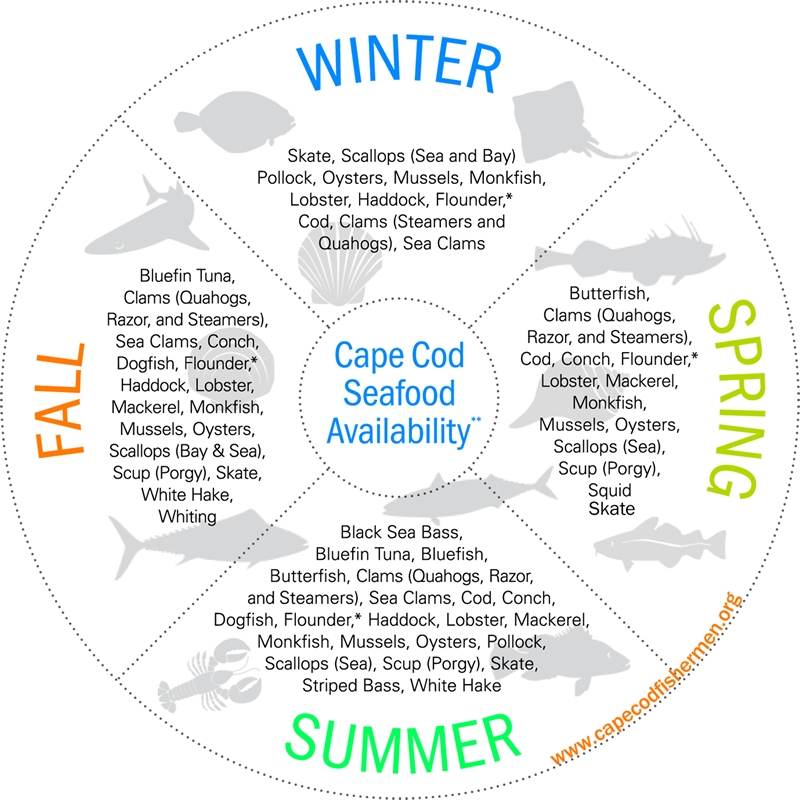Learn More
Ask for locally caught seafood at fish markets or restaurants to support the family fishermen of Cape Cod! Weather, seasonality, and regulations affect what kinds of seafood may be locally harvested at different times of year. Many markets have a combination of local and imported seafood. To eat with the seasons and support the local economy, ask your fishmonger what is local.
Have you ever wondered how seafood makes its way from the sea to your plate? It isn’t as simple as you might think. Take a detailed dive into the seafood supply chain on Cape Cod in our Seafood Supply Chain Report.
Cape Cod fishermen use a variety of fishing gear types to catch fish. Some fishermen specialize in a single gear type, while others may fish different gear types at different times of the year. Different gear is used to target different species, and adjustments can even be made within a gear type to catch different types of fish (i.e. “mesh size” or the size of the holes in a net). Gear types may be generally split into two categories –fixed gear and mobile gear. Fixed gear is stationary gear, anchored to the bottom that fishes passively by allowing fish, lobsters, etc. to come to the gear. Mobile gear is actively towed through the water for the target species.
Check out the Cape Cod seasonality chart for a guide on how to eat with the seasons.
To learn more about the importance of each local port, check out Port by Port: Profiles and Analysis of the Massachusetts Commercial Fishery. This report was prepared by Cape Cod Commercial Fishermen’s Alliance, Massachusetts Division of Marine Fisheries (DMF), and Urban Harbors Institute at the University of Massachusetts Boston for MA DMF.
Gillnet
The type of gillnets used locally by small-boat fishermen are anchored, sink gillnets(fixed gear). The nets are made of monofilament mesh and each panel measure 300 feet long by 10 feet high. Multiple net panels are strung together to make a “set” or “string” of nets. A weighted leadline and anchors at each end keep the net secured to the bottom. The polypropylene floatline (with floats) keeps the net upright in the water. At each end of the set,a line extends to a buoy and high flyer at the surface. Gilletting gets its name from the way it traditionally catches fish by the gills. Nets are strategically set to target different species. When hauled, fish are quickly hand-picked from the nets and the net is “flaked” out before setting the gear again. Mesh size is regulated to filter out small fish, and different mesh sizes are used to target different species (skates, monkfish, dogfish and groundfish, such as pollock and cod).
Otter Trawl
A mobile type of gear, an otter trawl is a funnel-shaped net towed behind a fishing vessel. “Otter” refers to the boards designed to keep the mouth of the net open. The speed of the trawl through the water gathers fish into the tail of the net, known as the “cod end.” Mesh size requirements and escape vents help protect smaller fish and turtles from being caught by accident. Otter trawling is used by fishermen targeting flounder and other groundfish.
Scallop Dredge
To target scallops, fishermen tow a dredge along the bottom(mobile gear). The dredge is made up of a triangular frame from which extends a “net” –the belly of which is made up of steel rings and the top section of thick twine. Size of the rings and mesh are regulated to allow smaller scallops to sift through. The dredge is winched up, then dumped upside down so the catch empties onto the deck where fishermen hand-pick the live scallops. A similar type of dredge, but with a hydraulic system, is used to harvest surf clams and quahogs. A large pump is used to push seawater through a hose connected to the front of the dredge. The hose jetswater into the sand, where the dredge then passes through to collect the large clams while smaller ones filter through the metal bars of the dredge.
Pots/Traps
Pots or traps are used to catch more than lobsters around Cape Cod –they are also used to catch black sea bass, scup, Jonah crabs, and conch (channeled whelk). Historians say the wooden lath and rope mesh lobster trap (also called a lobster “pot”) was invented on Cape Cod in the early 1800s, and the basic design—a baited box with a one-way entrance—is still in use, but most are made of wire now. Pots maybe be fished in singles (one pot per line), or connected together in trawls of multiple pots with buoys at each end. Lobster pots have escape vents to allow small lobsters to easily exit. Other pots also have requirements for escape vents or opening size to allow smaller animals to be filtered out. Strict regulations enforce low breaking strength line, breakaway sections/devices, and seasonal closures to avoid risk of entanglement to marine mammals.
Hook and Line
Officially known as bottom longline, the local “tub trawl” gear is used to target spiny dogfish and groundfish. This type of fixed gear consists of a weighted line that rests on the bottom with lines at each end that extend to buoys on the surface. Gangions extend off of the line on the bottom, and a baited hook hangs off of each gangion. The name tub trawl is derived from the method of the bottom longlines being coiled into “tubs” (fish totes). Another method of hook and line fishing is jigging. Fishermen let the line extend all the way to the bottom and use quick tugs of the line to catch groundfish.






